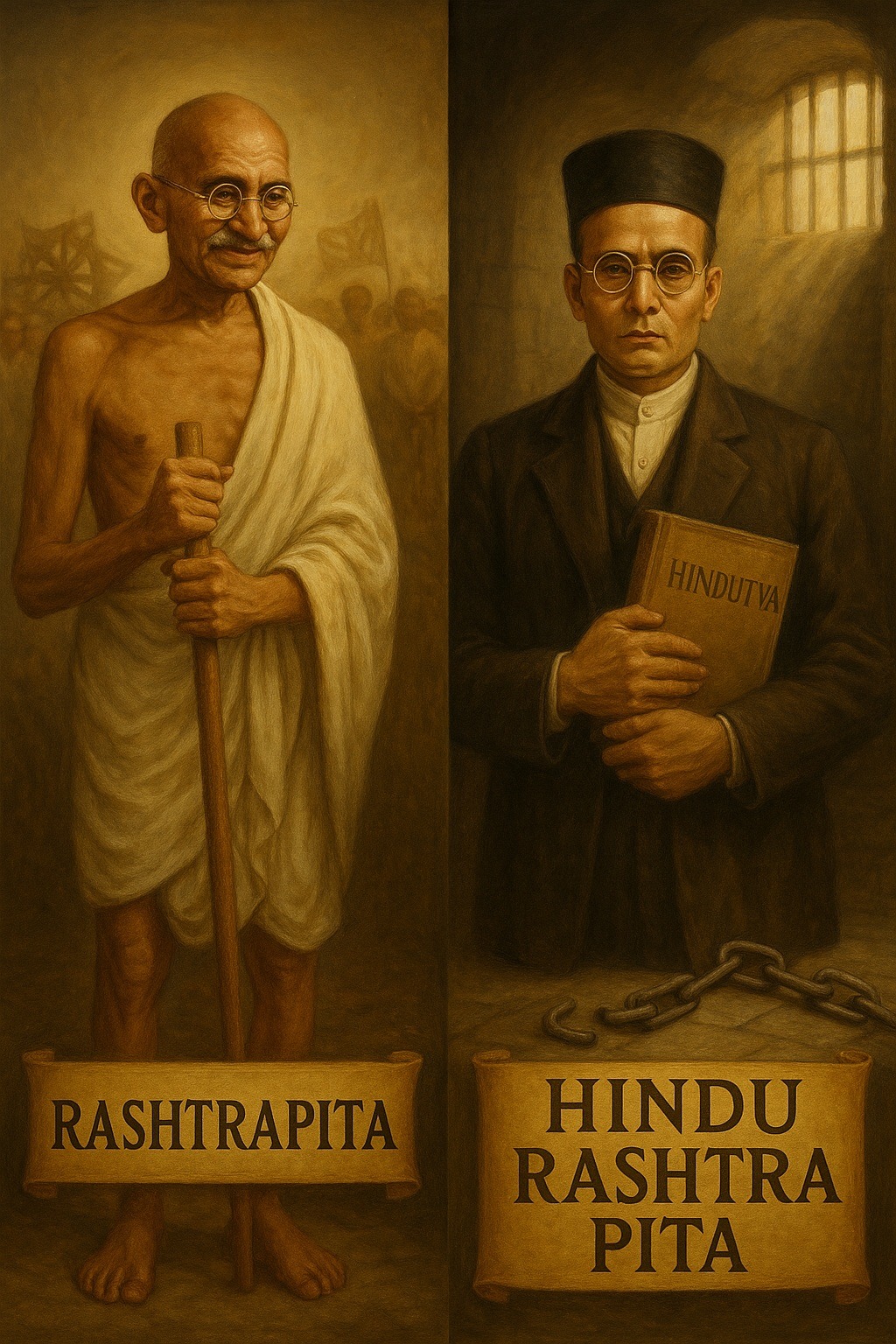Since M.K. (Mahatma) Gandhi is called by many of his followers Rashtrapita (“Father of the Nation”), it is fitting that Vinayak Damodar (Veer) Savarkar be acknowledged as Hindu Rashtra Pita—the “Father of the Hindu Nation.” This title recognizes not only his seminal contribution to the Indian freedom struggle but also his immense personal sacrifices and his pioneering role in formulating and articulating the political, cultural, and ideological vision of Hindu Rashtra.
Just as Gandhi is popularly remembered as Rashtrapita for shaping the moral and mass-based dimensions of India’s independence movement, many of Savarkar’s followers and subsequent admirers honored him as Hindu Rashtra Pita. This designation underscores his status as the chief architect of a distinct political philosophy centered on Hindu identity, unity, and sovereignty.
Why Savarkar Deserves the Title Hindu Rashtra Pita
- Unparalleled Suffering and Sacrifice in the Andamans
- Savarkar endured two life sentences, amounting to fifty years of imprisonment, in the infamous Cellular Jail in the Andaman Islands.
- He was subjected to inhuman conditions: solitary confinement, forced labor such as oil grinding, denial of basic human dignity, and relentless physical and psychological torture.
- Despite this, he continued to inspire fellow prisoners, writing poetry on the prison walls, preserving his intellectual vigor under brutal repression.
- Savarkar endured two life sentences, amounting to fifty years of imprisonment, in the infamous Cellular Jail in the Andaman Islands.
- Years of Internment and Political Marginalization
- After his release from the Andamans, Savarkar was confined to Ratnagiri under strict British surveillance and prohibitions.
- He was barred from active political participation, silenced from national platforms, and deliberately sidelined during crucial phases of India’s independence movement.
- Yet, during this period of enforced isolation, he redirected his energies toward social reform, working to dismantle caste barriers and promote Hindu unity.
- After his release from the Andamans, Savarkar was confined to Ratnagiri under strict British surveillance and prohibitions.
- Personal Sacrifices and Separation from Family
- Savarkar’s long years of imprisonment and internment meant decades of forced separation from his wife, children, and extended family.
- He sacrificed the possibility of a stable private life, devoting himself instead to the larger cause of national liberation and Hindu consolidation.
- Savarkar’s long years of imprisonment and internment meant decades of forced separation from his wife, children, and extended family.
- Vilification and Defamatory Campaigns
- The British colonial authorities sought to delegitimize him through defamatory portrayals, branding him a dangerous extremist.
- Even within India, rival political groups and intellectual critics launched campaigns to discredit him, labeling him “communal” or “anti-national.”
- Despite these attacks, his ideas survived, spread, and ultimately shaped the discourse on Hindu identity in modern India.
- The British colonial authorities sought to delegitimize him through defamatory portrayals, branding him a dangerous extremist.
- Visionary Role as Ideologue of Hindu Rashtra
- Through works such as Hindutva: Who is a Hindu?, Savarkar articulated a coherent and systematic vision of Hindu Rashtra, emphasizing cultural unity, civilizational pride, and national sovereignty.
- He redefined Hindu identity in political rather than purely religious terms, offering a unifying framework at a time of deep communal and colonial divisions.
- His thought provided the ideological foundation for subsequent Hindu nationalist movements and organizations.
- Through works such as Hindutva: Who is a Hindu?, Savarkar articulated a coherent and systematic vision of Hindu Rashtra, emphasizing cultural unity, civilizational pride, and national sovereignty.
Final Thought
Thus, just as Gandhi is remembered as Rashtrapita for embodying the spiritual and moral dimensions of India’s independence, Savarkar’s immense suffering, sacrifices, intellectual contributions, and enduring ideological legacy justify his recognition as Hindu Rashtra Pita. He transformed personal loss into collective inspiration, turning the Cellular Jail into a crucible of revolutionary thought and his years of silencing into a period of profound reformist activity.
Savarkar’s life exemplifies the idea that the freedom struggle was not only fought on the political battlefield but also within the crucible of personal sacrifice and ideological perseverance. To call him Hindu Rashtra Pita is to acknowledge this unique role: the father of a vision that sought to unite Hindus under a shared political, cultural, and civilizational destiny.
💭 What do you think? How do Savarkar’s years of imprisonment in the Andamans shape your understanding of his role in the freedom struggle? Do you think Savarkar’s long internment in Ratnagiri unfairly marginalized him in the mainstream nationalist movement? Is the title Hindu Rashtra Pita an adequate recognition of Savarkar’s sacrifices, or does it simplify his complex legacy? Which sacrifice strikes you as more significant: Savarkar’s loss of freedom, his separation from family, or the defamation campaigns against him? Just as Gandhi is called Rashtrapita (“Father of the Nation”), should Savarkar equally be remembered as Hindu Rashtra Pita? Why or why not? How do Savarkar’s ideas on Hindu unity and nationhood resonate in present-day India? Do you think Savarkar’s personal sacrifices are sufficiently acknowledged in school textbooks and public memory today?
👉 Share your thoughts in the comments below!
Sources:
KEER, Dhananjay. 1988. Veer Savarkar. Third Edition. (Second Edition: 1966). Popular Prakashan: Bombay (Mumbai).
SAMPATH, Vikram. 2019. Savarkar (Part 1). Echoes from a forgotten past. 1883-1924.Penguin Random House India: Gurgaon.
Savarkar, Vinayak Damodar. Hindutva: Who is a Hindu? (Nagpur: 1923; various reprints).
Savarkar, Vinayak Damodar. The Indian War of Independence of 1857. (1909; reprints by Veer Savarkar Prakashan, Bombay).
Savarkar’s speeches and writings compiled in: Savarkar Samagra, Vols. 1–10 (Maharashtra Prantik Hindusabha, Pune).
Visana, Vikram. 2021. ‘Savarkar before Hindutva: Sovereignty, Republicanism, and Populism in India, c.1900–1920’, in Modern Intellectual History 18, no. 4 (2021): 1106–1129. Cambridge, UK: Cambridge University Press.
WOLF, Siegfried O. 2009. Vinayak Damodar Savarkar und sein Hindutva-Konzept. Die Konstruktion einer kollektiven Identität in Indien [“Vinayak Damodar Savarkar and his concept of Hindutva: The construction of a collective identity in India.”]. Online Dissertation: Heidelberg University: Heidelberg.


Leave a Reply